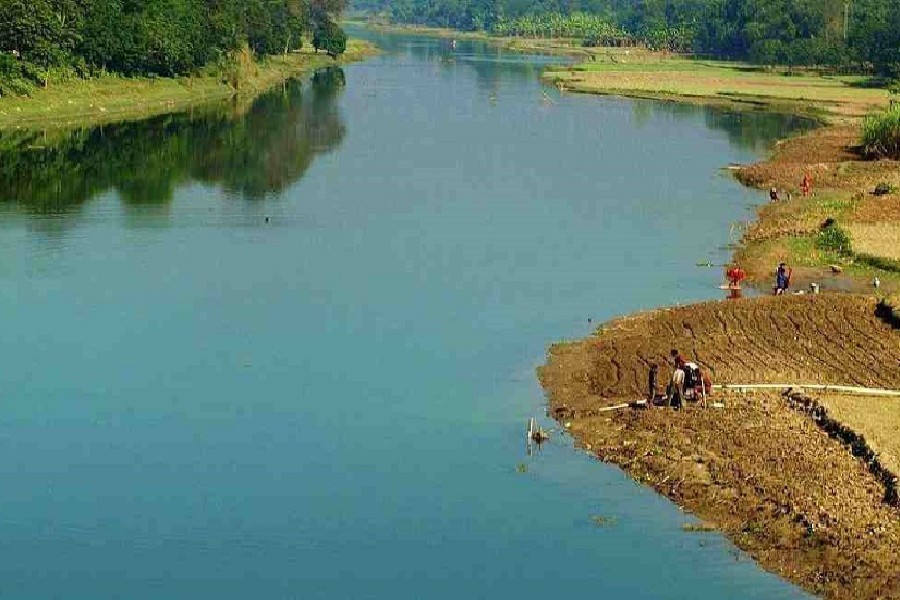"Amader choto nodi chole bankebanke (Meandering, flows down our small river) …." Educated Bengalee readers must have read these lines from a juvenile poem written by Rabindranath Tagore. In the poem, Tagore portrayed an idyllic picture of the rural river as it looks in summer. These rivers haven't vanished altogether from the greater Bengal. Many of them turn furious during monsoon. Their flood-fed width would expand fast amid nonstop downpours. This monsoon flooding leads to the devouring of the croplands and villages. The rivers during summer in the undivided Bengal remained more or less similar. The eastern part of the land, now Bangladesh, began witnessing weird behaviour of its rivers in the late-1970s. The untimely shrunken and overflowing, and thus, flood-triggering rivers became a common view in the country.
Many have blamed the Farakka Barrage sluice gates and the Teesta Barrage dams, all in India, for the drying-up and overflowing of the south-western and northern Bangladesh. However, after the 1996 signing of the water sharing treaty of the Ganges, a common river, the problem of the water crisis and flooding in Bangladesh has eased, to some extent. But the Teesta waters in the upper riparian India still remain a bane for Bangladesh.
To speak without mincing words, except 4/5 mighty rivers, most of the country's 750 rivers are mid-width and small flows. Moreover, of them a sizeable number remain dry even during monsoons. It's because they have long been disconnected from the nearby mother-rivers. Still, people love to call them rivers for different reasons. They vary from the fact that a few of them turn 'wild' in years, or river transports have yet to completely stop using them. Large vessels may have stopped plying; but engine-run small boats and country boats continue to travel through these rivers. Moreover, canals have branched out from them. Alongside these rivers, there are many existing only in name. Portions of them have been encroached on and filled up by local bigwigs leading to their extinction. According to river science, no river becomes completely extinct. On being favoured by phenomena conducive to their revival, the long dormant rivers come alive in their original forms.
Unfortunately for Bangladesh, only a handful of rivers come fully alive on being fed by the onrush of flood waters carried by a few upper riparian rivers in India's northeastern regions. This is what has happened to the swelling of the rivers in Bangladesh much ahead of monsoon in the recent years.
But amid these untimely floods, a pretty good number of rivers of the country continue to remain in their normal shape. Though it sounds unnatural, there were a few such rivers which had been flowing in the same pace for decades. But suddenly they changed their nature. Nowadays, they start showing their ferocity with the advent of monsoon. The reason is quite simple. Of late, with new urban settlements getting their heels dug on their banks and a fast growing dingy river port spreading its tentacles, the riverbeds are said to have been growing layers of sediments. As a result, almost every year the two banks of the rivers turn victims of flooding. This scourge leads to the inundation of large tracts of croplands and villages on one side, and the emerging semi-urban pockets on the other.
Lack of 'maintenance dredging' on regular basis, not keeping special funds for the project, leaving the work half done and many other acts of amateurism have long been blamed for the floods in unlikely places. And also the rivers' fast loss of navigability. It's the poor river management going on for decades, which results in both the shrinking of river flows and the rivers' becoming flood-prone. Unfortunately, whatever small amount is granted for the projects of river dredging, it ends up being misspent. But the reality Bangladesh has to face is it can trifle with the all-important task of river dredging at its own peril. The country cannot remain oblivious to the fact that it is surrounded by the landed territory of India on all sides except the Bay of Bengal on its south and a narrow strip of Myanmar in the southeast. Of the 57 trans-boundary rivers, 54 flow into the country from India, and three from Myanmar. Bangladesh receives both good sediments helpful for agro-growth and debris accumulated on the riverbeds from the Indian side. In the recent years, Bangladesh has to struggle with river waters flowing into the country from India's northeast. Due to the excessive rains flooding the upper riparian rivers on the Indian side, they enter Bangladesh carrying lots of sands, stone-chips, muddy sludge etc.
Flash floods will continue to submerge Bangladesh, unless there are joint technical devices adopted to stop the flows. The long planned Tipaimukh dam being built on the border of Mizoram and Manipur across the Barak River could have been an effective India-Bangladesh joint venture. But thanks to the identification of a few practical problems from the Bangladesh side, the flash flood mitigation project couldn't be materialised even in the last four decades. Although radically effective solutions lie in the bilateral embankment ventures to tame the flash floods, disagreements on some points impeded a permanent way out. In the interregnum, i.e. until a remedial measure could be devised, vast areas of northeastern Bangladesh may have to brace for floodwaters rushing from the upper riparian Indian states.
In reality, the days of knee-deep small rivers are gone. The flows of almost all of these rivers are hampered by the onrush of waters from upper riparian bigger rivers situated in the same country or across its borders. Due to its location on the banks of the downstream rivers flowing from India, northeastern Bangladesh may have to be destined to go through its yearly ordeals for an indefinite period. The nation awaits upper riparian India's proactive role in easing the stalemate.


